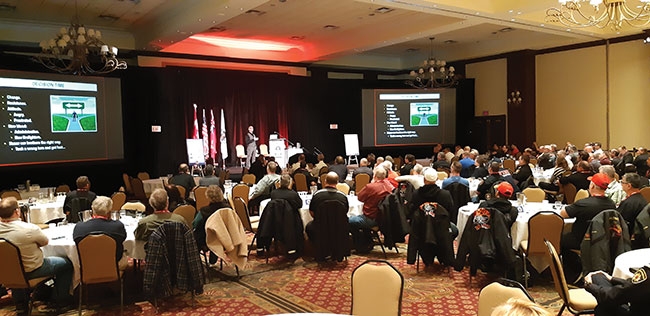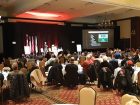
Features
Leadership
Lessons Learned
Firefighters at Station 11 in Charleston, South Carolina, were just finishing their evening meal around seven o’clock on Monday, June 18, 2007, when the alarm sounded. Someone had reported a fire at the back of a Sofa Super Store just down the road on the Savannah Highway.
May 15, 2019
By
Grant Cameron
 David Griffin speaks to senior fire service leaders at an Ontario Association of Fire Chiefs Northeastern Fire Education Conference and Trade Show in Huntsville Firefighters at Station 11 in Charleston
David Griffin speaks to senior fire service leaders at an Ontario Association of Fire Chiefs Northeastern Fire Education Conference and Trade Show in Huntsville Firefighters at Station 11 in CharlestonIt seemed like a routine call. Firefighters grabbed their gear and jumped on the truck. Little did they know, it would be a history-making call-out that ended up taking the lives of nine firefighters, becoming the deadliest firefighter disaster in the U.S. since the 9/11 terrorist attacks.
One of the firefighters who responded was David Griffin. He was 27 at the time. It was his first fire as a pump operator. He was on Engine 11, the first engine to respond.
“I had not pumped a fire yet,” he recalls. “This was my first chance.”
Griffin, now 39, recalled the devastating fire and the trauma that his fellow firefighters faced, at an Ontario Association of Fire Chiefs Northeastern Fire Education Conference and Trade Show at Deerhurst Resort and Conference Centre in Huntsville, Ont., on March 29.
During a morning session, and in an interview afterwards, he spoke about the firefighters – now known as the Charleston 9 – and mistakes made at the scene.
“Teaching on this so much and living through it has been difficult,” he says. “But I’ve tried to do something good and teach people because if I don’t teach on it then I feel there are a lot of lessons that will die and I can’t let that happen.”
Griffin became a battalion chief and deputy director of training in Charleston and is now chief fire officer with the Center for Public Safety Excellence in the U.S. He authored a book on the tragedy, titled In Honor of The Charleston 9: A Study of Change Following Tragedy.
He took the audience on an emotional ride, describing in detail what happened at the scene and how mistakes were made, to today where the organization is a national model for change. He presented a series of video footage, photographs and radio traffic from the scene in an effort to personalize the incident and drive his message home to the audience.
The radio traffic from the scene was disturbing and tragic. Over a 10-minute period, there were a lot of urgent radio transmissions from firefighters calling for help from inside the building. Eventually, a voice says, “Everybody abandon the building,” and “Everybody out of the building.”
“Many times, when you hear about line of duty deaths, you don’t have a personal connection,” said Griffin. “Many people read it and say, ‘This will never happen to us.’ But it can happen to you.”
Within 28 minutes, the fire destroyed the building and killed nine firefighters trapped inside.
Griffin had been on the job just over two years when the fire struck.
He talked about a series of mistakes that were made on the day of the fire. For example, he’d been cleaning the truck and had taken everything off the rig, so when the call came in he had to throw everything back on the truck. Upon arrival at the fire, firefighters didn’t have a sufficient water source and had to run a line across a busy highway.
There also wasn’t a proper accountability system in place so they didn’t know who was missing. A firefighter’s wife was told her husband was okay, but it was later determined he’d died.
The building itself also hadn’t been inspected in nine years because the municipality had stopped inspecting them on an annual basis.
And, when firefighters inside the building were calling for help, Griffin ended up “walking over” their transmissions because “I didn’t have the discipline.”
Firefighters dumped water on the fire for two hours and didn’t know who was missing. Off-duty firefighters came to help. Some were wearing the gear of others, so it was confusing.
Griffin talked about each of the firefighters who died that day. One was a barber who cut the hair of his crew, another was known for being calm at every fire, and yet another was engaged.
Afterwards, he said, the bodies of the firefighters were found in the charred ashes.
“That’s when it got real very, very quickly,” he says. “From 10:30 to 4:30 that’s all we did – body recovery.”
After the fire, Griffin made his way home, ate and went to bed. He went back for a shift at the fire hall the following week. People in the area were calling the firefighters heroes.
“We walked around for a week, thinking we did something special.”
In the weeks that followed, though, the firefighters were heavily criticized in the media. Griffin read reports that indicated more than 200 errors were made.
During his presentation, Griffin discussed The Routley Report which determined that the Charleston fire was predictable and the outcome preventable, that firefighting operations did not comply with regulations and the culture of the department exposed firefighters to unnecessary risks. The report also determined firefighters had insufficient training and equipment. A report by the National Institute of Standards and Technology also identified a number of issues.
The fire, and the horrendous number of line-of-duty deaths, resulted in changes and the beginning of change for both the City of Charleston and the fire service as a whole.
“We didn’t understand we made mistakes because you don’t know what you don’t know,” Griffin says.
The trauma of that night eventually took an emotional toll on Griffin. He turned to drugs and alcohol to deal with it.
He also competed in mixed martial arts competitions, but one night took a beating and, afterwards, spent three days reflecting.
“I realized what I was doing wasn’t helping anything,” he told the audience.
So, he did something about it. He got a doctorate of education and now speaks about the event in an effort to make sure such a tragedy doesn’t happen again.
Griffin believes the fire service must change the way it operates and adopt new methods in order to keep pace with the times. He also believes attitudes towards the job must change.
“We don’t feel we have to make progress until something happens and then it’s too late,” he says. “Like many organizations we were built on ego and bravado.”
For example, Griffin says that when he was a rookie an older firefighter told him to soak a sponge and put it in his mouth when he went to a fire instead of using an air pack. So, he tried it at a fire, but got only about 30 feet into the building and found the sponge didn’t work.
At the same fire, he had his helmet knocked off because his chin strap was around the back of his head because it looked cool.
He learned his lesson and warned the audience, “Remember you don’t have a duty to die. You have a duty to serve and go home to your family.”
Griffin says firefighters always need to be ready for action.
“We work in a dangerous profession,” he says, “but there are things we can do to prepare.”
When firefighters cross the threshold by jumping on a truck to head to a fire scene, they have to be ready, he says.
“That’s how we’re going to fix this.”
If firefighters don’t, he says, “eventually you’ll be going to a funeral.”
Print this page

